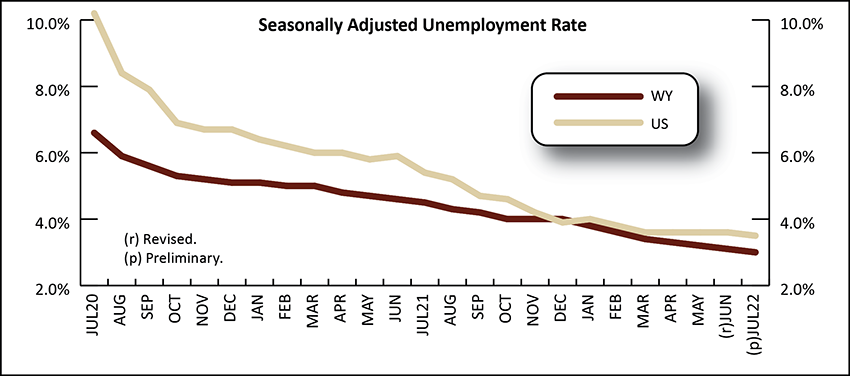Wyoming Labor Force Trends
September 2022 | Volume 59, No. 9
Click Here for PDF
Return to Table of Contents
News Release: Wyoming Unemployment Falls to 3.0% in July 2022
by: David Bullard, Senior Economist
The Research & Planning section of the Wyoming Department of Workforce Services reported that the state’s seasonally adjusted1 unemployment rate decreased from 3.1% in June to 3.0% in July. Wyoming’s unemployment rate is lower than its July 2021 level of 4.5% and lower than the current U.S. rate of 3.5%.
From June to July, most county unemployment rates followed their normal seasonal pattern and decreased. Unemployment rates often fall in July as job gains are seen in leisure & hospitality, construction, and professional & business services. The largest unemployment rate decreases occurred in Lincoln (down from 3.7% to 2.7%), Sublette (down from 3.8% to 3.2%), Uinta (down from 3.8% to 3.3%), and Teton (down from 2.2% to 1.7%) counties.
In July, unemployment rates were lower than their year-ago levels in every county. The largest decreases were reported in Natrona (down from 5.8% to 3.7%), Campbell (down from 5.3% to 3.3%), Niobrara (down from 4.1% to 2.2%), Converse (down from 4.7% to 2.8%), and Sweetwater (down from 5.7% to 3.9%) counties. Unemployment rates were elevated in 2021 because of the pandemic.
Teton County, at 1.7%, had the lowest unemployment rate in July. It was followed by Crook County and Niobrara County, both at 2.2%, and Weston County at 2.3%. The highest rates were found in Sweetwater County at 3.9%, and Fremont County and Natrona County, both at 3.7%.
Total nonfarm employment in Wyoming (not seasonally adjusted and measured by place of work) rose from 284,500 in July 2021 to 291,600 in July 2022, an increase of 7,100 jobs (2.5%). Employment was unusually low in 2021 because of economic disruptions related to the pandemic.
R&P's most recent monthly news release is available at https://doe.state.wy.us/LMI/news.htm.




.svg)
 Wyoming at Work
Wyoming at Work